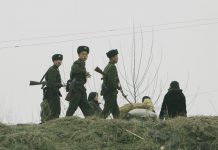
With the world going on alert due to the recent spread of the Omicron variant of COVID-19, North Korean authorities are focusing all their energy on bolstering quarantine efforts.
According to a Daily NK source in North Hamgyong Province on Thursday, the Central Emergency Anti-epidemic Headquarters issued an order to quarantine headquarters nationwide on Nov. 28 calling on them to strengthen quarantine efforts and take thorough measures to deal with the situation.
In North Hamgyong Province, the authorities responded the same day with an emergency meeting of officials ranked section chief and above from provincial and city quarantine stations, provincial and city hospitals and local clinics. The meeting ordered doctors to take thorough measures and manage their domains to prevent fever patients from emerging within their jurisdictions.
In particular, it stressed that doctors visit households in their jurisdiction twice a day from Nov. 29 — the very next day — to check for fever or other symptoms, immediately reporting their results to hospitals and quarantine stations.
The source said doctors were also threatened with punishment if fever patients emerge in their districts, or if they fail to quickly identify patients with suspicious symptoms and take appropriate measures.
Specifically, the source said they were threatened with transfers to rural hospitals or even being stripped of their credentials, depending on the severity of their mistake.
North Korea has been using the “section doctor system” – where doctors are in charge of seeing patients in a particular area – to prevent the spread of COVID-19 since the start of the pandemic. However, there is reportedly considerable public discontent with the arrangement.
The section doctor system began from the Seventh Meeting of the Second Supreme People’s Assembly in February of 1960. The meeting called for “complete, general free medical treatment” throughout the country. The authorities officially declared the launch of the new system during the Fourth Party Congress in September the following year.
Later, the authorities planned even denser systems of healthcare, including a “residential system” based on places of residence and a “workplace system” based on factories and enterprises.
However, free medical treatment has existed in name only since the 1990s, as has the section doctor system.
While doctors have been visiting families in their jurisdictions in the morning and afternoon to check temperatures, they are reportedly showing little interest in treating sick patients.
The source said doctors are only taking daily temperatures, providing no medication for complaints. He ruefully added that doctors are showing exclusive interest in fevers as they face punishment for outbreaks in their areas of responsibility.

















